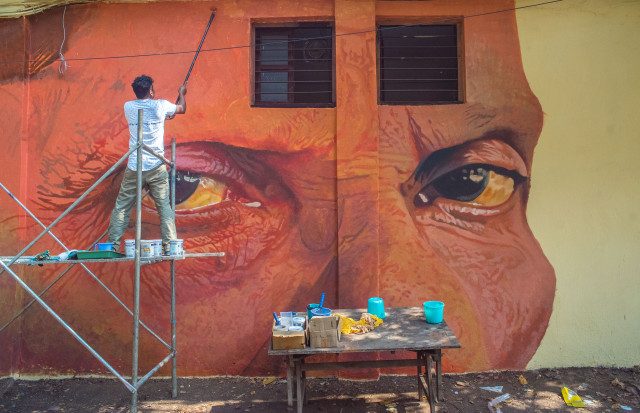Goa has never seen street art take shape the way it did at the recently concluded Serendipity Arts Festival. The St+art Goa Project curated by Hanif Qureshi was met with mixed feelings and good cheer at the festival.
The St+art Goa Project
During the Serendipity Arts Festival, it was difficult to miss seeing the billboard-style cut outs, murals and artwork that were placed in strategic areas of Panjim. Probably done to provoke all kinds of reactions, these were all a part of the The the St+art Goa project curated by Hanif Qureshi.
The aim was to make art accessible to everyone. In doing so, a group of international and national artists got together to paint the streets in Panaji as part of the festival. The aim was to make art accessible to everyone. In doing so, a group of international and national artists got together to paint the streets in Panaji as part of the festival. All over the world, street art is gaining a lot of popularity. Modern day artists are going everywhere, painting and leaving their mark on the streets.
“The theme of the artworks was Goa and Goans and how Goa looks at outsiders and how outsiders look at Goa,” says Hanif. He strongly feels that the streets of Panaji can be turned into a walk-in art gallery soon. “We feel that this place could be developed as an art gallery where one can walk and discover arts and do away with doors and timings,” says Hanif, while speaking to the newspapers.
Street art in Goa works its magic
The St+art India Foundation has organized a lot of similar exhibitions all over the country. They have now brought in street art with international artists including Guido Van Helten (Australia), Curiot (Mexico), Do and Khatra (India), Parag Sonarghare (India), Daku, Ayaz Basrai, Kafeel, Shabbu among others.
The street art in Goa can be seen at various places; there’s the multi-level car-park in Patto, the PWD complex near the old Patto bridge, the road near Clube Nacional and on the wall of Junta House on 18th June Road.
“Street art is something you are not expecting to see and when you discover it, it creates a larger impact. Through these artworks we nurture Indian talents and contemporary artists,” says Hanif. He states that when something is in a public space, everyone has their own view and understanding of it. “An image can have different connotations to different people and they can decode it differently,” he adds.
Any space can be a canvas for street art
Hanif was also a part of last year’s Serendipity Arts Festival. He decided to do the groundwork for this project back then itself. He walked around Panjim looking for possible spaces where the artists could leave their mark. “I moved around the streets in the city during my 21-day stay in Goa. I strongly feel that art can change the dynamics of the surrounding like it did for the wall near Clube Nacional. The place which was earlier used as a toilet has now become a colourful street and people no longer mess it up.”
The street art project was not the only project that was a part of the St+art Goa project. There were two more – Shutters Project and Cut-Out Project. For the Shutters Project, 11 shutters all over the city were painted with a lesson in vocabulary and proverbs that were used by our grandparents. “The Shutter Project passes on the proverbs once used by our grandparents to the present generation. A generation before us used it as part of their day-to-day language. These shutters are a great medium to pass down a local proverb to the new generation,” says Hanif who adds that the proverbs have been written in Konkani and Latin.
The Cut-out Project is another cool one. Characters of Goa were put up at different places in the city. “The Cut-out Project looks at Goan personalities. Through the cut-outs we have put up characters of Goa, not stereotyping it but keeping it general,” says Hanif.
Even though the festival ended on the 22nd of December, 2017, the cut-outs were up for a few days more. Even though they are long gone, one can still see the shutters with the proverbs and the painted walls around Panjim.
Information credit – Navhind Times
ItsGoa/JAN/KDGP


